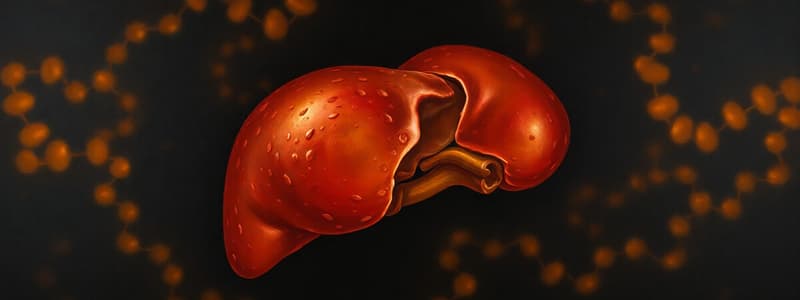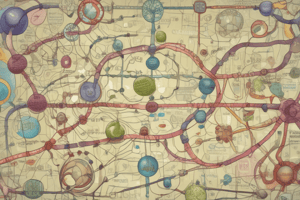Podcast
Questions and Answers
What is the primary organ responsible for gluconeogenesis?
What is the primary organ responsible for gluconeogenesis?
- Heart
- Liver (correct)
- Pancreas
- Muscle
Which of the following three-carbon precursors is NOT involved in the formation of glucose during gluconeogenesis?
Which of the following three-carbon precursors is NOT involved in the formation of glucose during gluconeogenesis?
- Acetyl-CoA (correct)
- Alanine
- Lactate
- Glycerol
During starvation, what is the approximate contribution ratio of gluconeogenesis from the liver and kidneys?
During starvation, what is the approximate contribution ratio of gluconeogenesis from the liver and kidneys?
- 80/20
- 70/30
- 90/10
- 50/50 (correct)
Which of the following processes occurs in the liver and kidneys?
Which of the following processes occurs in the liver and kidneys?
Which enzyme is unique to gluconeogenesis?
Which enzyme is unique to gluconeogenesis?
What role does skeletal muscle primarily play in gluconeogenesis?
What role does skeletal muscle primarily play in gluconeogenesis?
What is the primary carbon source for gluconeogenesis during prolonged fasting?
What is the primary carbon source for gluconeogenesis during prolonged fasting?
Which of the following substrates is directly utilized in gluconeogenesis to synthesize glucose?
Which of the following substrates is directly utilized in gluconeogenesis to synthesize glucose?
What is the function of phosphoglucomutase in glycogen synthesis?
What is the function of phosphoglucomutase in glycogen synthesis?
What is the role of glycogen synthase in glycogen synthesis?
What is the role of glycogen synthase in glycogen synthesis?
Which enzyme is responsible for branching during glycogen synthesis?
Which enzyme is responsible for branching during glycogen synthesis?
What is required for de novo glycogen synthesis to occur?
What is required for de novo glycogen synthesis to occur?
How many glucose residues must glycogenin add to itself to initiate glycogen synthesis?
How many glucose residues must glycogenin add to itself to initiate glycogen synthesis?
What type of linkage forms between glucose molecules in glycogen during synthesis?
What type of linkage forms between glucose molecules in glycogen during synthesis?
What happens when glycogen chains become longer than 10 units?
What happens when glycogen chains become longer than 10 units?
Which molecule is activated before being added to glycogen during synthesis?
Which molecule is activated before being added to glycogen during synthesis?
What is the general process for adding glucose units to glycogen?
What is the general process for adding glucose units to glycogen?
What enzyme is responsible for creating G1P from glucose residues on glycogen?
What enzyme is responsible for creating G1P from glucose residues on glycogen?
What is the role of debranching enzyme during glycogenolysis?
What is the role of debranching enzyme during glycogenolysis?
How is G1P converted to G6P in the glycogenolysis pathway?
How is G1P converted to G6P in the glycogenolysis pathway?
What triggers glycogenolysis in skeletal muscle?
What triggers glycogenolysis in skeletal muscle?
What type of linkages are involved in the glucose residues that are removed by the debranching enzyme?
What type of linkages are involved in the glucose residues that are removed by the debranching enzyme?
What happens to the glucose produced from the conversion of G6P?
What happens to the glucose produced from the conversion of G6P?
What is the primary function of glucagon in relation to glycogenolysis?
What is the primary function of glucagon in relation to glycogenolysis?
During glycogenolysis, when the branches of glycogen are four residues long, what is the first action of the debranching enzyme?
During glycogenolysis, when the branches of glycogen are four residues long, what is the first action of the debranching enzyme?
What condition typically triggers the need for glycogenolysis in skeletal muscle?
What condition typically triggers the need for glycogenolysis in skeletal muscle?
Which enzyme is responsible for breaking down G6P to glucose?
Which enzyme is responsible for breaking down G6P to glucose?
Which of the following enzymes is specific to gluconeogenesis to bypass the irreversible steps of glycolysis?
Which of the following enzymes is specific to gluconeogenesis to bypass the irreversible steps of glycolysis?
What process links the metabolism of lactate and glucose during gluconeogenesis?
What process links the metabolism of lactate and glucose during gluconeogenesis?
Which of the following precursors is NOT typically involved in gluconeogenesis?
Which of the following precursors is NOT typically involved in gluconeogenesis?
Where does gluconeogenesis predominantly occur in the body?
Where does gluconeogenesis predominantly occur in the body?
During gluconeogenesis, where does the conversion of pyruvate to phosphoenolpyruvate (PEP) take place?
During gluconeogenesis, where does the conversion of pyruvate to phosphoenolpyruvate (PEP) take place?
What is the role of bifunctional enzymes in gluconeogenesis?
What is the role of bifunctional enzymes in gluconeogenesis?
Which cycle involves the conversion of alanine to glucose in the liver?
Which cycle involves the conversion of alanine to glucose in the liver?
Which hormone is primarily involved in stimulating gluconeogenesis?
Which hormone is primarily involved in stimulating gluconeogenesis?
In what form is glycogen primarily stored in the body?
In what form is glycogen primarily stored in the body?
Which enzyme is crucial for the synthesis of glycogen from glucose?
Which enzyme is crucial for the synthesis of glycogen from glucose?
Von Gierke disease is primarily associated with a deficiency in which enzyme?
Von Gierke disease is primarily associated with a deficiency in which enzyme?
Which metabolite primarily provides carbon skeletons for gluconeogenesis?
Which metabolite primarily provides carbon skeletons for gluconeogenesis?
What happens to gluconeogenesis during fasting state?
What happens to gluconeogenesis during fasting state?
Which type of glycogen storage disease is known as Pompe disease?
Which type of glycogen storage disease is known as Pompe disease?
What is the initial product formed when alanine is deaminated in the liver?
What is the initial product formed when alanine is deaminated in the liver?
What cannot pass through the inner mitochondrial membrane during gluconeogenesis?
What cannot pass through the inner mitochondrial membrane during gluconeogenesis?
Which molecule is formed from malate or aspartate in the cytosol?
Which molecule is formed from malate or aspartate in the cytosol?
Which hormone is known to stimulate gluconeogenesis?
Which hormone is known to stimulate gluconeogenesis?
What molecule is required for the conversion of PEP to glucose during gluconeogenesis?
What molecule is required for the conversion of PEP to glucose during gluconeogenesis?
Which of the following is an inhibitor of fructose-1,6-bisphosphatase?
Which of the following is an inhibitor of fructose-1,6-bisphosphatase?
What is the main role of the PDH complex in metabolism?
What is the main role of the PDH complex in metabolism?
Through which pathway does glycerol enter gluconeogenesis?
Through which pathway does glycerol enter gluconeogenesis?
What is the energy requirement to produce one molecule of glucose during gluconeogenesis?
What is the energy requirement to produce one molecule of glucose during gluconeogenesis?
What role does cAMP play in regulating gluconeogenesis?
What role does cAMP play in regulating gluconeogenesis?
What type of molecule is biotin in the context of metabolism?
What type of molecule is biotin in the context of metabolism?
Which gluconeogenesis precursor originates from the breakdown of triacylglycerols?
Which gluconeogenesis precursor originates from the breakdown of triacylglycerols?
How do fatty acids contribute to gluconeogenesis?
How do fatty acids contribute to gluconeogenesis?
In what condition does insulin fall and glucagon rise, influencing gluconeogenesis?
In what condition does insulin fall and glucagon rise, influencing gluconeogenesis?
Flashcards are hidden until you start studying
Study Notes
Gluconeogenesis
- Glucose is made from three-carbon precursors
- Lactate
- Alanine
- Glycerol
Gluconeogenesis vs Glycolysis
- Gluconeogenesis is the process of producing glucose from non-carbohydrate sources
- Glycolysis is the breakdown of glucose into pyruvate
- Gluconeogenesis and glycolysis share some enzymes
- Gluconeogenesis uses enzymes specific only to this process
- Gluconeogenesis also uses allosteric regulators
Gluconeogenesis Location
- Most gluconeogenesis takes place in the liver (90%)
- The kidneys account for the remaining 10%
- In starvation, the ratio between liver and kidney gluconeogenesis shifts to 50% for each
- Gluconeogenesis in the liver and kidney is vital in the body
Gluconeogenesis Precursors
- Alanine is a major precursor of glucose, produced from muscle breakdown
- Glutamine is also a precursor of glucose, produced from muscle breakdown
- Alanine and glutamine are used in the glucose-alanine (Cahill) cycle, where they are transferred from muscles to the liver
Gluconeogenesis Process
- Gluconeogenesis uses steps that are reversible to glycolysis
- Gluconeogenesis uses four bypass reactions to circumvent irreversible steps from glycolysis
- Gluconeogenesis uses a series of reactions to convert pyruvate to glucose
- Gluconeogenesis starts in mitochondria with pyruvate carboxylase
- Gluconeogenesis then uses phosphoenolpyruvate carboxykinase to convert oxaloacetate to phosphoenolpyruvate
- Gluconeogenesis ends in the cytoplasm, with the conversion of glucose-6-phosphate to glucose
Gluconeogenesis Regulation
- Gluconeogenesis is regulated by hormones such as insulin and glucagon
- Gluconeogenesis is also regulated by the availability of substrates
- The liver plays a major role in regulating blood glucose levels
Conditions Affecting Gluconeogenesis
- Starvation can lead to increased gluconeogenesis as the body seeks to maintain blood glucose levels
- Alcohol consumption inhibits gluconeogenesis, leading to hypoglycemia
Key Notes
- Gluconeogenesis is vital in maintaining blood glucose levels
- Gluconeogenesis is regulated by a complex interplay of substrates and hormones
- Gluconeogenesis is essential for energy production in the body.
Gluconeogenesis Regulation
-
Pyruvate carboxylase (PC) is an important enzyme in gluconeogenesis.
-
Regulation of hepatic glucose metabolism is vital, and a schematic overview highlights crucial enzymes and metabolites.
-
Gluconeogenesis and hepatic glucose output are controlled by a complex network of enzymes and metabolites.
Glycogen Synthesis
- Glucose-6-phosphate (G6P) is converted to glucose-1-phosphate (G1P) by phosphoglucomutase.
- G1P is converted to UDP-glucose by UDP-glucose pyrophosphorylase.
- UDP-glucose is activated and can be added to glycogen molecules.
- Glucose from UDP-glucose is added to the end of the glycogen chain (α-1,4 linkage) by glycogen synthase.
- As the chain lengthens, the branching enzyme cleaves 7 glucose residues from the growing end and adds them to the 6-carbon of a pre-existing glycogen molecule (α-1,6 linkage) to form a branch.
- This process repeats, creating more branches, but it only works on pre-existing glycogen molecules (8 glucose residues or more).
- De novo glycogen synthesis requires glycogenin, which adds 8 glucose residues to itself from UDP-glucose.
- Once there are at least 8 glucose residues, glycogen synthase can take over.
Glycogen Degradation
- Glycogen phosphorylase creates G1P from glucose residues on the non-reducing ends of glycogen.
- When branches are 4 glucose residues long, the debranching enzyme removes 3 residues from the branch and adds them to the end of the core chain (4:4 transferase activity).
- It also removes the remaining glucose that is α-1,6 linked (α-1,6-glucosidase activity).
- G1P is converted to G6P by phosphoglucomutase.
- G6P is converted to glucose by G6Pase.
Regulation of Glycogenolysis
- Glucagon stimulates glycogenolysis.
- Calcium ions (Ca2+) stimulate glycogenolysis.
- Epinephrine (adrenaline) stimulates glycogenolysis.
- Insulin inhibits glycogenolysis.
Summary of Glycogen Storage Diseases
- These diseases are caused by deficiencies in enzymes involved in glycogen metabolism.
- Symptoms vary depending on the specific enzyme deficiency.
- Many glycogen storage diseases are fatal.
- Treatment options include diet, exercise, and medication.
Studying That Suits You
Use AI to generate personalized quizzes and flashcards to suit your learning preferences.



